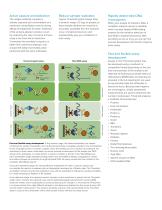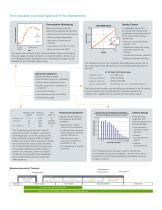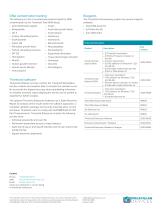
Catalog excerpts

Threshold Immunoassay SystemA better way to analyze biomolecules BENEFITS • Use your own antibodies to develop sensitive immunoassays • Liquid phase binding to maximize molecular interaction • Active capture and detection using a silicon biosensor • Reduce sample replicates • Rapidly detect total DNA in picograms Introduction The Threshold® System was developed to address difficulties scientists experience when attempting to develop highly sensitive and reproducible immunoassays without using radioactivity. While ELISAs are a common alternative, they are frequently affected by the sample matrix and often require a significant development effort to achieve uniform saturation of antibodies from well to well and plate to plate. Further complications arise when reducing the background by blocking non-specific binding to the microplate. The results are often disappointing: the desired levels of assay sensitivity and reproducibility are not achieved. Based on these experiences, it was clear that a better way to develop sensitive immunoassays was needed. The Threshold system with Immuno-Ligand Assay (ILA) and Total DNA Assay reagents addresses this problem. Develop sensitive immunoassays All reagents are provided in kit form to label your antibodies (or commercially available antibodies) quickly and easily for use in the Threshold System. In a short time, you can develop a highly sensitive and reproducible assay using the ILA Detection Kit. Maximize molecular interaction To optimize the interaction between the antigen and antibody, binding occurs freely in solution where the molecules are maintained in their native conformation and the antibodies retain 100% of their activity.
Open the catalog to page 1
Active capture and detection Reduce sample replicates The antigen-antibody complex is actively captured and concentrated on a membrane using filtration and the strong affinity of streptavidin for biotin. Detection of the enzyme-labeled complex occurs by measuring the rate of enzyme turnover using a low-noise silicon biosensor. Commonly, the sensitivity is equal to or better than radioimmunoassays, and at least 10X better than ELISAs when performed with the same antibodies. Typical Threshold system assays have a dynamic range of 2 logs or greater, so fewer sample dilutions are required to...
Open the catalog to page 2
Fermentation Monitoring Maximize product yield by determining optional harvest time • Detect onset of protein expression • Monitor product degradation • May detect conformational changes • Fast results in less than an hour • More sensitive than HPLC The speed and sensitivity of the Threshold System allows monitoring of the early stages of protein production during fermentation. Since it is an immunoassay, protein degradation and confirmational changes may be detected by the Threshold system assay. Quality Control A validatable method for accurately and reproducibly quantitating contaminant...
Open the catalog to page 3
proteins tested for DNA DNA Assay: Insulin Insulin-like growth factor Insulinotropin Interferons Interleukins Monoclonal Ab Neuropeptides Somatotropins Superoxide dismutase Tissue plasminogen activator Urokinase Vaccines Viral antigens DNA contamination testing The following is a list of recombinant contamination by the Threshold Total • Anti-inflammatory agents • Atriopeptide • CD 4 • Colony stimulating factors • Erythropoietin • Factor VIII • Fibroblast growth factor • Follicle stimulating hormone • GP 120 • Hemoglobin • Hirudin • Human growth hormone • Human serum albumin • Immunotoxins...
Open the catalog to page 4All Molecular Devices catalogs and technical brochures
-
EMax Plus Microplate Reader
4 Pages
-
ImageXpress Pico
8 Pages
-
GenePix 4000B Microarray
2 Pages
-
SpectraMax iD5
8 Pages
-
CloneMatrix
2 Pages
-
Transfluor Technology
3 Pages
Archived catalogs
-
MetaMorph NX
4 Pages
-
MetaFluor Software Brochure
6 Pages
-
MetaXpress
6 Pages
-
EMax Plus Microplate Reader
3 Pages
-
FlexStation 3
6 Pages
-
SpectraMax MiniMax 300
3 Pages
-
SpectraMax M series
6 Pages
-
SpectraMax Paradigm
6 Pages
-
SpectraMax i3x
6 Pages
-
CloneMatrix - Data Sheet
1 Pages




























